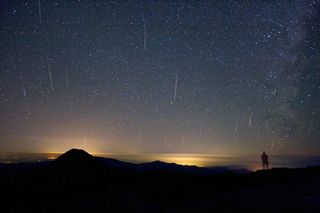Weekend Light Show? Draconid Meteor Shower Due Saturday

Look to the sky on Oct. 8 and you might catch a falling star — or 750. Astronomers are predicting an outburst of Draconid meteors, up to 750 an hour, this weekend as Earth passes through dust streams of Comet 21P/Giacobini-Zinner.
Unfortunately, the sight may not be a show stopper, as its peak is expected to occur during daylight hours in the U.S. and even the tail end of the show could be drowned out by the moon's light. Other regions have better chances of catching the sky lights.
The Draconids are a regular October occurrence, but 2011 could be a particularly active year, according to NASA. Earth is expected to pass through at least three dust filaments left behind by Comet Giacobini-Zinner. The comet shoots through the inner solar system about every six-and-a-half years, leaving trails of debris behind. Earth usually grazes a filament or two, according to NASA Science News, but this year the planet should run into several filaments head-on.
When the bits of particle dust enter Earth's atmosphere, they burn up, creating streaks of light across the sky. Most Draconids burn up before reaching the ground, and they're slow enough to pose relatively little risk to satellites and spacecraft like the International Space Station. [Image Gallery: Looking Back at Earth From Space]
It's hard to predict how many meteors will show up during the Draconids. The comet's debris produced serious light shows in 1933 and 1946, with full-on meteor storms of thousands of shooting stars per hour. In 1988 and 2005, the Draconids also provided impressive meteor outbursts, but some years bring only one or two meteors per hour.
Observers in Europe, north Africa and the Middle East have the best chance of seeing the Draconids at their peak this year. The strongest activity is predicted between 1900 and 2100 UTC on Oct. 8, which is 3:00 p.m. to 5:00 p.m. EDT. That means most meteors will likely occur during daylight hours in the United States, but skywatchers may catch sight of some of the brighter meteors after sunset.
According to NASA's Jet Propulsion Laboratory, the best way to secure a good view of a meteor shower is to get as far away from light pollution as possible and to pay attention to the darkest patch of sky you can find. Meteors travel away from the constellation after which they are named, so look for Draconids that seem to originate from the constellation Draco.
Sign up for the Live Science daily newsletter now
Get the world’s most fascinating discoveries delivered straight to your inbox.
And temper expectations: With a full moon coming on Oct. 12, light from the waxing moon may drown out most shooting stars.
You can follow LiveScience senior writer Stephanie Pappas on Twitter @sipappas. Follow LiveScience for the latest in science news and discoveries on Twitter @livescience and on Facebook.

Stephanie Pappas is a contributing writer for Live Science, covering topics ranging from geoscience to archaeology to the human brain and behavior. She was previously a senior writer for Live Science but is now a freelancer based in Denver, Colorado, and regularly contributes to Scientific American and The Monitor, the monthly magazine of the American Psychological Association. Stephanie received a bachelor's degree in psychology from the University of South Carolina and a graduate certificate in science communication from the University of California, Santa Cruz.
